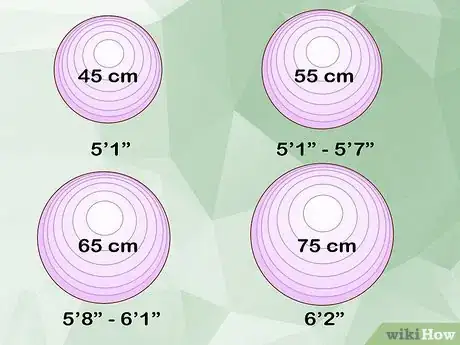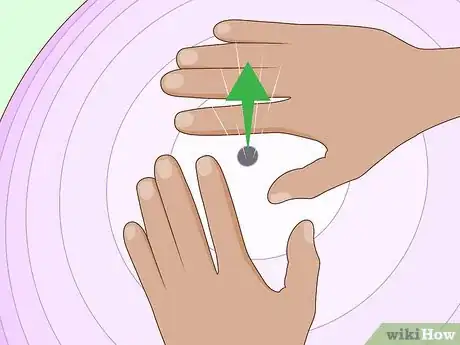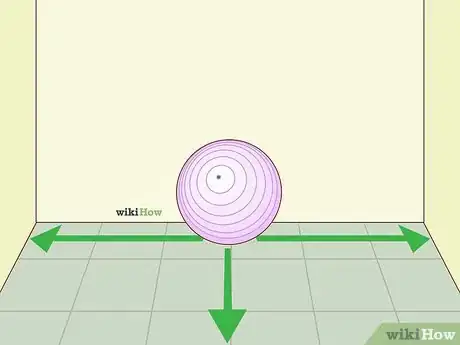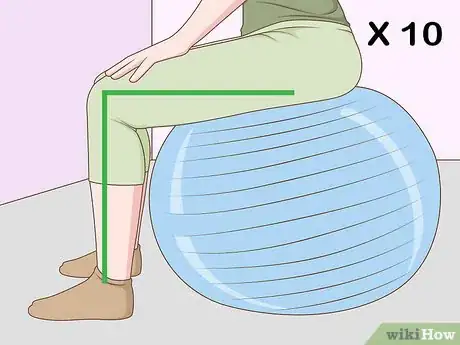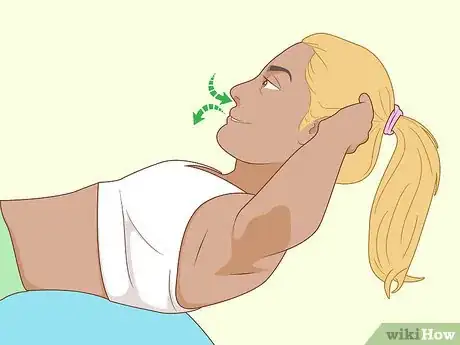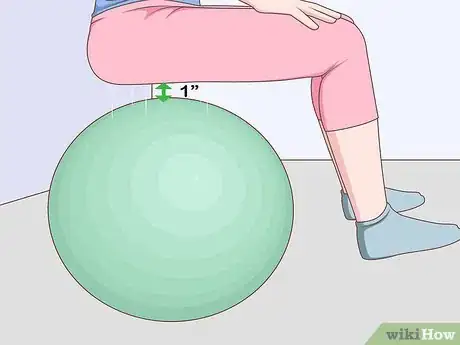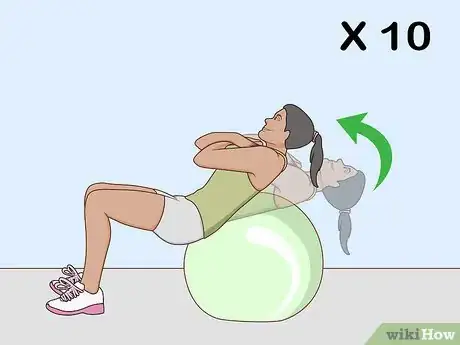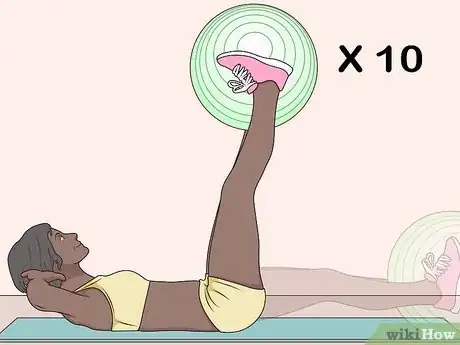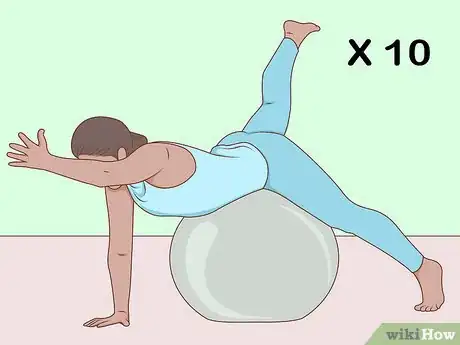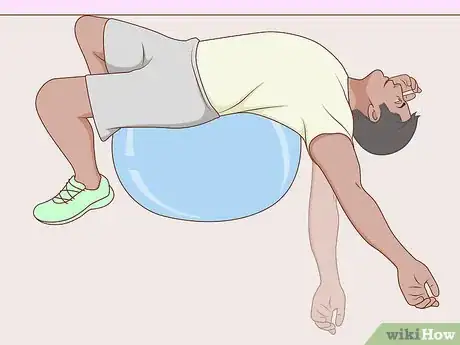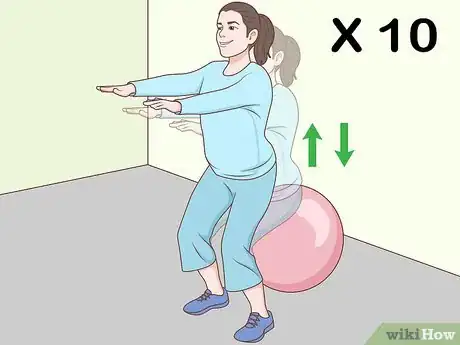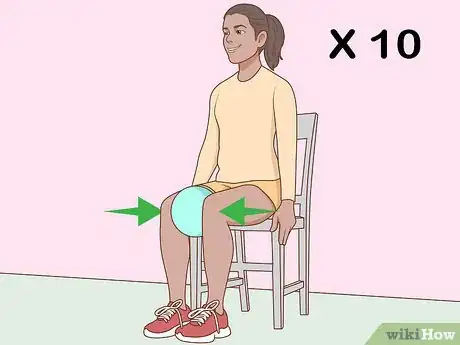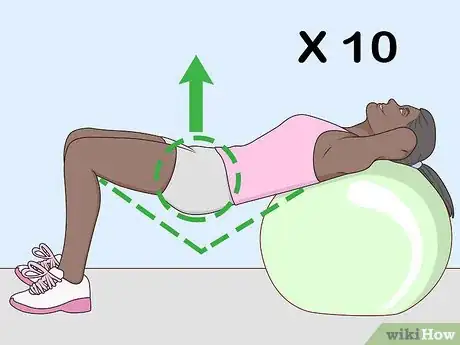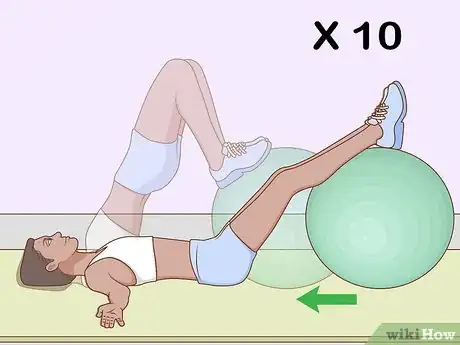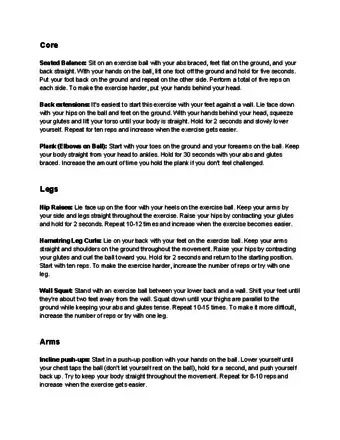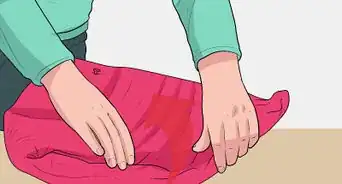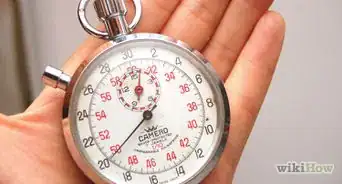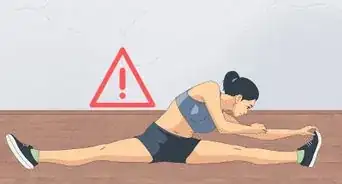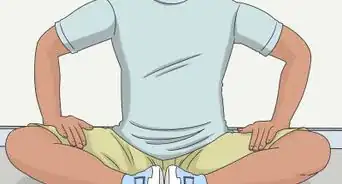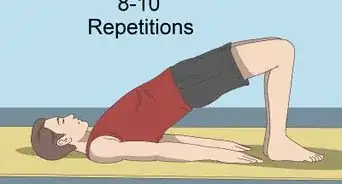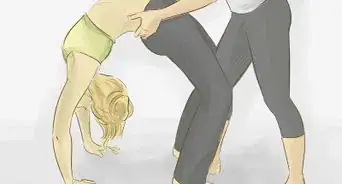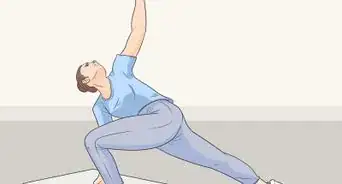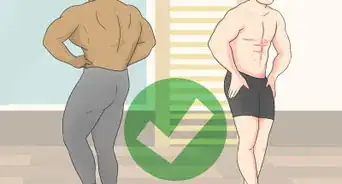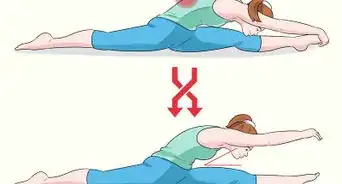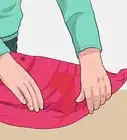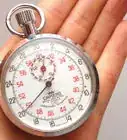This article was co-authored by Adam Shuty. Adam Shuty is a Certified Strength and Conditioning Specialist and owner of ATOMIC Total Fitness, a fitness training studio in New York, New York. With over 15 years of experience, Adam specializes in weightlifting, strength and conditioning, and martial arts. Adam holds a BS in Industrial Engineering from Virginia Polytechnic Institute and State University. In 2014, Adam appeared on the Live With Kelly and Michael Show as one of the top five fitness instructors in the country.
There are 10 references cited in this article, which can be found at the bottom of the page.
wikiHow marks an article as reader-approved once it receives enough positive feedback. This article received 14 testimonials and 91% of readers who voted found it helpful, earning it our reader-approved status.
This article has been viewed 325,812 times.
Exercise balls are a useful workout tool for strengthening your core and assisting with balance exercises, such as pelvic thrusts. The ball can be difficult for beginners because it creates an unstable surface, but with a little practice, an exercise ball can be a great tool and even help you use your muscles in new ways.[1] The best way to use an exercise ball as a beginner is to practice simple core and leg exercises to build your confidence.
Steps
Using the Exercise Ball Correctly
-
1Select the correct size for your height. When you sit on the ball, both feet should be flat on the floor, and your knees should be bent at 90-degree angles. If you’re buying your exercise ball online and can’t test it out, buy one based on your height. The following exercise balls roughly relate to your height:[2]
- If you’re shorter than 5’1” (155 cm), try a 45 cm ball.
- If you are between 5’1” and 5’7” (155 to 170 cm), choose a 55 cm ball.
- If you are between 5’8 and 6’1” (173 to 185 cm), choose a 65 cm ball.
- If you’re taller than 6’2” (188 cm), choose a 75 cm ball.
-
2Deflate the ball slightly for easier use. A firmer ball with more air pressure will make the exercises harder, so you might want to use a ball with lower air pressure when you’re just starting out. When you pump it up, stop when it is pumped up and can hold your weight but still has some give when you push on it.[3]
- As you get stronger, you can place more air into the ball to make it firmer.
Advertisement -
3Use your exercise ball in an open area. You can use your exercise ball indoors and outside -- the most important thing is that you have enough space to move around. Before exercising, remove any sharp or heavy objects from the area to minimize the potential for accidents.[4]
-
4Sit on the exercise ball with your feet flat on the floor and your knees bent at a 90-degree angle. Your knees should be directly over your ankles, and your back should be straight. Place your feet hip-width apart or, if you're struggling to stabilize yourself, spread them wider.[5]
-
5Breathe during each exercise. When you’re exercising on the exercise ball, breathe in through your nose and out through your mouth. It might help to count as you do, to make sure you’re breathing slowly and evenly.[6]
Performing Beginner Core Exercises
-
1Bounce on the ball lightly. When you bounce on the ball, you want to keep your core muscles engaged so you can stay balanced up on the ball. You shouldn’t be moving more than 1 inch (2.5 cm) off the ball.[7]
-
2Use the ball to perform a sit up. Sit on the ball with your feet flat and at hip width, and your core engaged. Cross your arms over your chest and lean back, walking your feet forward until your lower back rests on the ball. Your body should make a straight line from your knees to the top of your head.[8]
- Tuck your chin and lift your shoulders and head until you can see your knees. Do not sit up all the way. You just want to flex the space between the top of your hips and your rib cage. Return to the reclining position.
- Repeat the sit-up at least 10 times.
-
3Do a ball lift. Lie on your back with the exercise ball between your feet. Clasp your hands behind your head. Engage your abs and squeeze the ball between your feet. Keep your legs straight and lift the ball towards the ceiling. Stop when your legs are perpendicular to the floor.
- Lower the ball back to within one inch of the floor, but don’t touch the floor.
- Repeat the ball lift at least 10 times.
-
4Do a ball plank. Get into the position you would for a normal plank, but place your feet on the exercise ball. This exercise is great for working your abdominals.[9]
-
5Do a bird dog. Lower yourself onto your hands and knees over the exercise ball. Make sure the exercise ball is securely under your abs. Raise one arm while raising the opposite leg. Keep your arm and leg straight and extend them away from your body as far as you can. Use the ball to balance yourself and keep your hips stable.[10]
- After a few seconds, lower your limbs down in a controlled manner. Raise the opposite arm and leg.
- Do this 10 times on each side.
-
6Perform a back extension. While facing the floor, roll your stomach onto the top of the exercise ball. As you do this place your feet against the wall behind you. Gradually fold your body over the top of the ball to get a good back extension.[11]
-
7Perform ab balances. Get on your hands and knees over the exercise ball with the ball pressing into your hips. Raise your knees off the floor just a little until you are balanced on your toes or balls of your feet. Contract your abs as you lift your arms off to the side, in the shape of a T. Once you are balanced, move your arms forward into a Y shape. Hold for a moment. Then, move your arms straight so that your body is a straight line.[12]
- Repeat four times.
Doing Beginner Leg Exercises
-
1Try a leg extension. Sit on the ball with your feet flat and at hip distance while keeping your core engaged. Lift one foot and straighten your leg. Your calf should be parallel to the floor. Hold the position for 10 seconds. Use your other leg and your abs to keep the ball stable.[13]
- Release your foot back to the floor and lift your other foot. Repeat the leg extension 10 times on each side.
- If you can’t straighten your leg at first, start by lifting your foot off the ground and holding your knee up. This will build strength, too.
-
2Do a ball half-squat. Rest the ball against a wall so it doesn’t move. Sit on the ball in the proper position. Push your weight back into your heels as you lift off the ball. Stop halfway up, with your knees still bent and thighs engaged.[14]
- Slowly return back to the ball to your seated position.
- Repeat 10 times.
-
3Perform a wall squat. Stand with your back to the wall. Place the exercise ball between yourself and the wall, at your lower back. Lean back against the ball and walk your feet forward one to three steps. The distance you step forward depends on the length of your legs. Engage your abs and remain leaning against the ball as you lower yourself into a squat. Your knees should be in line with your ankles and your thighs parallel to the floor.[15]
- If your knees extend over your ankles, or are behind your ankles, adjust the position of your feet.
- Hold the squat for 10 to 20 seconds. Push back up to standing. Repeat the squat at least 10 times.
-
4Do an inner thigh squeeze. Sit on the edge of a chair with your back straight. Place the ball between your knees, with your knees wider than your hips. Start the move by squeezing your knees together while engaging your core. Lean back one to two inches as you squeeze the ball. Return back to start while relaxing your knees around the ball, but making sure not to drop it.[16]
- Repeat 10 times.
-
5Perform bridges. Sit on the ball with your arms crossed over your chest. Then, walk your legs out and move down the ball until it rests under your head and shoulders. Your feet should be flat on the floor under your knees. Your hips, shoulders, and knees should form a straight line. Without moving the ball at all, lift your hips while tightening your buttocks and hamstrings, and then lower your hips.[17]
- Repeat 10 times.
-
6Try hamstring curls. Lie on your back on the floor. Rest your feet on the exercise ball. Bend your knees as you move the ball towards your buttocks with your feet as you lift your hips slightly off the floor. Hold for a second and return to start.[18]
- Repeat 10 times.
Sample Exercises
Expert Q&A
-
QuestionDo I need an exercise ball to do these exercises?
 Adam ShutyAdam Shuty is a Certified Strength and Conditioning Specialist and owner of ATOMIC Total Fitness, a fitness training studio in New York, New York. With over 15 years of experience, Adam specializes in weightlifting, strength and conditioning, and martial arts. Adam holds a BS in Industrial Engineering from Virginia Polytechnic Institute and State University. In 2014, Adam appeared on the Live With Kelly and Michael Show as one of the top five fitness instructors in the country.
Adam ShutyAdam Shuty is a Certified Strength and Conditioning Specialist and owner of ATOMIC Total Fitness, a fitness training studio in New York, New York. With over 15 years of experience, Adam specializes in weightlifting, strength and conditioning, and martial arts. Adam holds a BS in Industrial Engineering from Virginia Polytechnic Institute and State University. In 2014, Adam appeared on the Live With Kelly and Michael Show as one of the top five fitness instructors in the country.
Certified Strength & Conditioning Specialist Not at all! An exercise ball adds an extra strengthening element, but many of these exercises can be done without any special equipment.
Not at all! An exercise ball adds an extra strengthening element, but many of these exercises can be done without any special equipment.
References
- ↑ Adam Shuty. Certified Strength & Conditioning Specialist. Expert Interview. 26 August 2020.
- ↑ http://www.mayoclinic.org/healthy-lifestyle/fitness/multimedia/fitness-ball/vid-20084753
- ↑ http://www.mayoclinic.org/healthy-lifestyle/fitness/multimedia/fitness-ball/vid-20084753
- ↑ http://www.physiosupplies.com/blog/ps/56/choosing-the-right-exercise-ball-and-how-to-get-the-most-from-it/
- ↑ https://www.spine-health.com/wellness/exercise/how-start-exercise-ball-program
- ↑ https://ball-exercises.com/exercises/abs/
- ↑ https://www.spine-health.com/wellness/exercise/how-start-exercise-ball-program
- ↑ http://www.mayoclinic.org/healthy-lifestyle/fitness/multimedia/core-strength/sls-20076330?s=3
- ↑ Adam Shuty. Certified Strength & Conditioning Specialist. Expert Interview. 26 August 2020.
- ↑ http://www.webmd.com/fitness-exercise/features/10-fun-moves-to-reshape-your-body-with-exercise-ball-workout#2
- ↑ Adam Shuty. Certified Strength & Conditioning Specialist. Expert Interview. 26 August 2020.
- ↑ http://www.webmd.com/fitness-exercise/features/10-fun-moves-to-reshape-your-body-with-exercise-ball-workout#2
- ↑ https://www.spine-health.com/wellness/exercise/beginning-exercise-program-exercise-ball
- ↑ http://www.diabeticlivingonline.com/diet/fitness/easy-exercise-ball-workout?page=4
- ↑ https://www.spine-health.com/wellness/exercise/beginning-exercise-program-exercise-ball
- ↑ http://www.diabeticlivingonline.com/diet/fitness/easy-exercise-ball-workout?page=3
- ↑ http://www.webmd.com/fitness-exercise/features/10-fun-moves-to-reshape-your-body-with-exercise-ball-workout#2
- ↑ http://www.webmd.com/fitness-exercise/features/10-fun-moves-to-reshape-your-body-with-exercise-ball-workout#2
About This Article
To get started using an exercise ball, make sure that when you sit on it, your knees are at a 90-degree angle, and your feet are flat on the floor. Then, try some beginning core exercises, which can be as simple as bouncing up and down lightly with your core muscles engaged. Next, try some sit-ups by leaning back, resting the ball against your lower back, walking your feet forward so they’re at a 90-degree angle, then sitting up slowly until you can see your knees. For our exercise reviewer’s tips on how to use an exercise ball for leg exercises like squats and hamstring curls, read on!

